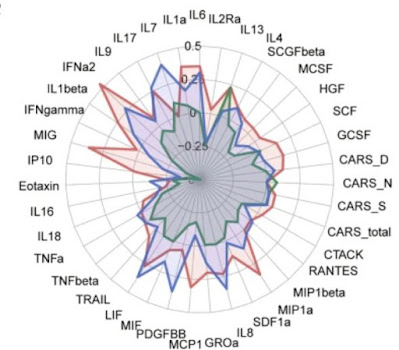The Olso to Bergen line is one of Europe’s most beautiful railways
I did have
another sense of déjà vu, when I read about the big spike in autism in one city
in Norway. Norway is a very expensive
country, but well worth a visit. We
enjoyed it. One of Monty’s former 1:1
assistants emigrated to Norway to work in their excellently funded special needs
therapy system.
A decade ago, there was a peak in media interest in Somali autism clusters in Sweden, Minneapolis and San Diego. Refugees had been taken to live in far away lands, with very different environmental conditions. They soon started to produce children with a very high incidence of autism. This was a surprise to all the academics and a shock to the parents. The Somali-Swedes even started calling it the Swedish disease, because they had never encountered such children before in Somalia.
Swedish study dissects autism risk in immigrants
Swedish migration: Only specific groups of immigrants — those from low-income
countries and those who migrated near or during pregnancy — have an increased
risk of autism, suggests a new study.
The Swedish Disease
A few hundred posts later after my one on the “Swedish disease”, it really is absolutely no surprise that the Norwegians have experienced the same phenomenon.
Risk of autism seven times higher in Norwegian
children with immigrant mothers
A study was conducted after health professionals started noticing a
concerning pattern.
Researchers concluded in a recent Norwegian study that children of foreign-born mothers have a far higher risk of being diagnosed with autism. The study included 142 children aged 2-6 years old with an autism diagnosis in Sør-Trøndelag in mid-Norway.
The risk of autism in these children was just over seven times higher if the children were born of immigrant mothers.
The over-representation of this population indicates that the mothers' immigrant backgrounds may impact the development of autism, the researchers behind the study write in an article in Tidsskriftet, the journal of the Norwegian Medical Association.
The actual research paper:
Autism spectrum disorder in preschool children in
Sør-Trøndelag 2016–19
BACKGROUND
Autism spectrum disorder (ASD) is an umbrella term covering a
range of conditions characterised by challenges with social interaction,
restricted interests and repetitive behaviours. The prevalence of ASD has
increased significantly in recent years, and there is a clinical impression of
a preponderance of cases among young children whose mothers were not born in
Norway.
The study included 142 children aged 2 to 6 years who were
diagnosed with autism in the county of Sør-Trøndelag, Norway in the period
2016–2019. The following information was collected: age at onset of symptoms
and diagnosis, primary diagnosis, ADOS-2 (Autism Diagnostic Observation
Schedule) scores, whether the child was born in Norway and the mother's country
of birth.
Children of mothers born
outside of Norway had a 7.7 times higher risk of being diagnosed with autism
than children of Norwegian-born mothers, with an annual
incidence of 0.74 % and 0.10 % respectively. These children were
diagnosed earlier, at an average age (standard deviation) of 41.9 (11.8) and
51.8 (18.1) months respectively (95 % CI 4.7 to 15.2); a p-value of
<0.001 for the difference. They also had a higher ADOS score, with an
average (standard deviation) of 19.0 (6.2) and 15.3 (7.1) respectively.
The preponderance of autism diagnoses may be an indication that
the mothers' country of
origin has an impact on the development of the condition. This has
implications for adaptions to the assessment and follow-up of this patient
group.
The incidence of autism spectrum disorder was higher among
children of migrant mothers than children of Norwegian-born mothers.
Children of migrant mothers were younger at the time of diagnosis and had more severe symptoms than children of Norwegian-born mothers.
Clinical impressions suggest an overrepresentation of autism spectrum disorder (ASD) among young children of migrant mothers and that the severity of ASD is greater in this group. This impression is supported by an official Norwegian report from 2020, where data from the Norwegian Patient Registry suggests an increased risk of autism in young children with a minority background (1).
Age at symptoms onset in preschool children with autism spectrum disorder in Sør-Trøndelag 2016–19 divided into six-month intervals (n = 133). The difference in reported symptom onset between the two groups is not statistically significant.
Country of origin for mothers of preschool children diagnosed with ASD in Sør-Trøndelag 2016–19 (N = 142).
The
study included 142 children in Sør-Trøndelag diagnosed with ASD in the period
2016–19 (Table 1). Parents of 80 of the children (56 %) reported their
first concern about symptoms between 12–24 months of age (Figure 1). The
difference in age at symptom onset between children of migrant mothers and
children of Norwegian-born mothers was not statistically significant.
Previous studies support our findings of an increased risk for ASD in children of migrant mothers (9–11, 22).
We found a higher mean ADOS score in children of migrant mothers compared with children of Norwegian-born mothers. This group was also younger at the time of diagnosis. A plausible explanation could be that these children were identified and examined at an earlier age because they had more severe symptoms. An Australian study (12) found that children of mothers who migrated from low-income countries were younger at the time of diagnosis and had an increased risk of intellectual disability. Our findings may indicate greater severity of the disorder in children of migrant mothers. The association between higher ADOS scores and early age of diagnosis was shown in both groups. This indicates that young children with clear signs of developmental disorder are identified and evaluated early, regardless of the mother's country of origin.
A Swedish study (10) found that the mother's migration background increased
the risk for ASD independent of the migration background of the father. A
Finnish study (11) found no increased risk of ASD among children where
only the father had a migrant background.
CONCLUSION AND IMPLICATIONS
This study supports the clinical impression that ASD is
overrepresented among children of migrant mothers. The incidence of ASD was 7.7
times higher in children of migrant mothers than children of Norwegian-born
mothers. Our findings also suggest that children with ASD of migrant mothers
are younger at the time of diagnosis and have more severe symptoms.
It’s the Immune
system, forget Vitamin D
One explanation for those Somali autism clusters a decade ago was vitamin D; researchers thought that the pregnant mothers in Sweden were short of sunshine. But what about the big Somali autism cluster in very sunny San Diego?
The immune system adapts very slowly
to its environment and gets used to living along side a wide family of bacteria from the environment.
Adults will struggle to adapt to changes in their bacterial environment. Consider a Western backpacker travelling around India on the cheap, he is going to get sick, or just lose a lot of weight. I chose the latter when I did this. If you want to lose weight, take a budget trip to India. Visit Scandinavia and you will not get sick, but it will lighten your wallet.
For the fetus created in Somalia, it is the lack of exposure to the expected bacteria in Sweden or Norway that upsets the immune system. It ends up over-reacting and damaging itself.
Conclusion
Migration from very poor countries to
very rich ones, while pregnant, risks seriously disrupting development of the
immune system of the fetus and its vital calibration process. The result may be autism or other
neurological conditions. In Norway a 7-fold
increase in autism has been found; they did not measure the impact on related, but
less troubling disorders like ADHD and dyslexia.
Not only is there 7x more autism, but
it is more severe autism, with a higher score on the ADOS scale.
Clearly many people do not get advance
knowledge of when they might become a refugee.
Very poor countries have very high birth rates and so young females are
quite likely to be pregnant at any given time.
We know that any kind of severe stress
also increases the incidence of autism.
Examples in the research include extreme weather events like hurricanes.
Wars, fleeing from home, journeying overland in harsh conditions will be very
stressful.
We can use this data to further the
wider understanding of how the immune system is a factor in the increase in autism
prevalence worldwide. We can then consider modifying the immune system to
protect the future fetus from autism and indeed pure auto-immune conditions
(asthma, eczema, IBS etc). The simple
way to do this is to add back exposure to bacteria that your grand parents and great
grand parents would have been exposed to.
In particular, this means exposure to domesticated animals, even just
cats and dogs.
We were recently in Pelion, Greece and
over there you cannot avoid contact with animals. Cats and dogs are roaming freely in cafes and
restaurants, mainly outside but not exclusively. Several times a day you will brush up against
some four-legged new friend. Are
auto-immune diseases less prevalent in Greece? What do you think?
Ideally you would be exposed to cows,
horses, sheep, goats etc. Take a hike through
the countryside or visit a farm. Don’t
try and sterilize your shoes afterwards.
This kind of animal contact is nowadays
uncomfortable to many people, but over tens of thousands of years your immune
system has been trained to expect it.
Another take home message is that
nobody is reading all this autism research and putting the pieces together; you
have to do it for yourself.



